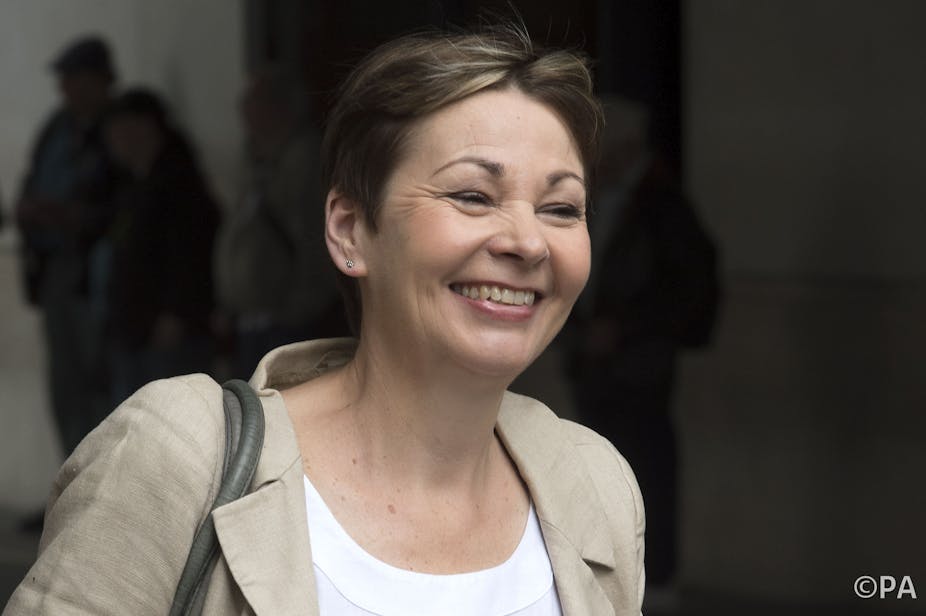Even the most eager gambler would have struggled to find odds yesterday for the Green Party leadership contest. One betting site was inviting customers to suggest rates. The obvious interpretation of this is that the contest was too predictable and too peripheral to interest the gambling public. But, in fact, only the former is true.
Sure enough, the firm favourite Caroline Lucas has been announced as the new joint leader. Lucas is the party’s only member of parliament and has already served as leader between 2008 and 2012 when she stood down to focus on her Brighton constituency. Crucially, this time around, she will share the leadership with Jonathan Bartley.
The dual candidature of Lucas and Bartley in this contest, which was prompted by Natalie Bennett’s decision not to seek a third term as leader, has been described as “truly radical”. Lucas said on winning that “we are incredibly proud to be the first leaders of a political party in this country to be job sharing”.
In fact the idea of joint or dispersed leadership is neither as novel, nor as significant to this contest, as some of the media coverage has implied. The Conservatives had no single leader for six years between 1911 and 1922, for example. The Liberal Democrats started out with two leaders, following the merger of the “two-headed” Alliance partnership.
And the development of devolved institutions has split the focus of nationalist leadership away from Westminster. So the SNP has a leader in Scotland and a leader in the British parliament – as indeed do the other parties.
Even the most ostensibly independent leaders have to share power, of course, as in the effectively dual premiership of Tony Blair and Gordon Brown. Some have suggested that this was already the case in the Greens before Bennett’s departure.
Where next for the Greens?
The sweeping victory of Lucas and Bartley says more about the likely direction of the Greens, though. Their campaign was based on a very explicit bid for co-operation with other leftist parties in a “progressive alliance”. The aim would be to agree not to fight over parliamentary seats in the next election in order to focus on taking on the right.
Other leadership candidates dismissed the prospect of making a deal. Some were also suspicious of crowning Lucas as the once and future monarch of the party. The fear that Lucas and Bartley were carried forward as mainstream media favourites with a nomination list of the Greens’ great and good which railroaded opposition might be given credence by their 86% share of the first preferences cast – they might have done too well to make it look like an equal contest.
The familiar tension between purist “dark green” radicalism and electoralist, broader environmentalism is visible here in the concerns about Lucas and Bartley ticket.
Bartley once worked for the Conservatives, which is a difficult pill for some on the left to swallow. That pill has been somewhat sweetened by the idea of the joint leadership with Lucas – which is presented as a nod to decentralisation and the limitation of over-powerful leadership, to which radical Greens are particularly committed. Before 2008, the party resisted even having a leader at all. Instead, it maintained a revolving panel of “principal speakers”. Aware that there remain doubters in her own ranks, Lucas was careful to reassure conference-goers after winning that “the distinctive Green Party message matters more than ever”.

The real significance of the new Green leadership will become more evident on the fringes of the other parties’ conferences over the next few weeks. Lucas continues to push for inter-party co-operation, calling for Labour “to recognise that a more plural politics is in both their electoral and political interests”.
How Labour, the Liberal Democrats and the nationalists (who, in Wales, have run joint campaigns with the Greens before) react will be the test of the importance of this leadership election.
As the fate of the last government showed, England – in Disraeli’s fabled phrase – “does not love coalitions”. They are suspicious of most inter-party deals. However, the tacit co-operation between Tony Blair and Paddy Ashdown’s Liberal Democrats in 1997 was the basis of great electoral success and forged a parliamentary combination supporting major constitutional changes including devolution and the introduction of the Human Rights Act.
The Greens came away from 2015 with a million votes and an increased membership. That gives them leverage with Labour. And with the Conservative government rowing back on some important green policies brought in under the coalition with the Liberal Democrats between 2010 and 2015, there is a clear clear platform on which to campaign.
Until the formula and conditions for achieving co-operation are reached, however – in the right issues being on the public agenda and the willing co-operation of personalities in other parties – the odds are that Lucas and Bartley will remain only potentially significant as leaders of the Green Party.

